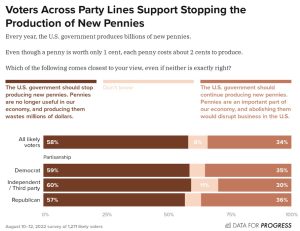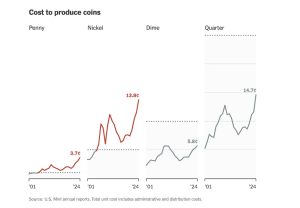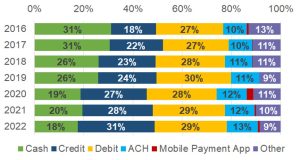Valery Vayserberg | Spring 2025
One of the hottest topics on the minds of Americans is the budget deficit of the United States. In 2024, the deficit was a whopping $1.83 trillion, bringing the nation’s debt to nearly $36.5 trillion. There has been a renewed energy of the current administration to reduce government spending in hopes of reducing the debt through the creation of the Department of Government Efficiency (DOGE). While many of the funding cuts have been strongly opposed by members of the opposing party and general citizens alike, there has been one issue which seems to remain bipartisan: stopping the production of the penny.
On February 9th, 2025, President Trump took to Truth Social to state, “For far too long the United States has minted pennies which literally cost us more than 2 cents. This is so wasteful!” This then led to an order to his Secretary of the Treasury to stop minting new pennies. The president’s move is another step in a decades-long battle which can be traced back to the 1990s with Phillip Diehl, a Democrat who ran the U.S. mint department and has advocated for the removal of the penny. In the present day, Democratic governor Jared Polis of Colorado voiced support for Trump’s penny-eliminating proposal.

This belief isn’t one only held by politicians and government officials: it is also held by the people. A 2022 study conducted by Data for Progress, a left-leaning think tank and polling group, found that 58% of voters believe the United States should stop producing the penny, as shown in Figure 1. It is important to note that this high level of approval occurred during a heavy inflationary period, with inflation reaching up to 9.1% (U.S. Bureau of Labor Statistics), although Americans who are in favor of penny-abolishment should have little to fear, as this movement has persisted for decades. Economists have also determined that, based on principle, this should be a bipartisan issue. Robert Whaples, an economist from Wake Forest University, claimed in 2012 that this issue should be championed by both political parties for the following reason: conservatives are concerned with minimizing governmental waste, and liberals are concerned with minimizing environmental waste.

As seen in figure two, the penny isn’t the only coin which faces higher production costs than its value, so why is it the only coin facing mass scrutiny? The nickel, which would become substantially more useful if the penny were to be eliminated, costs nearly 14 cents to produce. Do the American people care as much about eliminating the nickel, considering its high production costs? The short answer: no. In the same study conducted by Data for Progress, only ⅓ of voters felt the nickel should halt production. This could be due to the fact of a barrier (you cannot eliminate the nickel prior to the penny) and that it would cause prices to jump up to the nearest increment of 10 when paying in cash. Could the nickel face a similar struggle as society continues to move towards digital payment options and costs continue to rise? Possibly. But before economists and the general public can consider eliminating the nickel, the penny has got to go.
The use of the penny and production costs have an inverse relationship. After the COVID-19 pandemic, consumer behavior drastically changed in regards to payment methods. In research conducted by the Federal Reserve Bank of San Francisco (2023), it was found that by 2022, cash payments were down 13% compared to 8 years prior. Yet according to the U.S. Mint Department (2018) the cost to produce a penny has increased 52.6% in the same time period.

Not only is the penny effectively useless for the average consumer, it is damaging to the environment. The Central Bank of the Republic of China, for example, emphasizes the uselessness of loose change and states, “When people don’t use their coins and leave them at home, the central bank then has to produce more to meet demand, which raises the bank’s costs and also produces more carbon emissions.” Therefore, the costs far outweigh the benefits for mining additional minerals for the purpose of penny creation.
There may be concern over this policy proposal for a multitude of reasons, including upcharges seen on everyday products. While there is public concern over this topic, economists have disagreed over its impact. Robert Whaples, who was previously mentioned, addressed some of these concerns in his research, titled “TIME TO ELIMINATE THE PENNY FROM THE U.S. COINAGE SYSTEM,” (2007) which served to disprove the findings of Raymond Lombra, who in 2001 claimed eliminating the penny could have serious adverse effects.
Lombra examines the “rounding tax” which is the commonly held idea that, if the penny were to be eliminated, prices would more often increase to the nearest increment of 5 rather than lower in price. Yet Whaples points out that most items are taxed regardless, and that in Canada, one of the most infamous cases of removing one-cent payments, the rounding tax nearly does not exist. The argument Whaples makes can be summarized as follows: “The number of times consumers’ bills would be rounded upward is almost exactly equal to the number of times that they would be rounded downward,” with a minimal impact of a one cent increase in price every 40 purchases.
This isn’t a radical proposal; in fact, the United States could be considered late to the game. Canada ended production of their one-cent coin in 2012, with Sweden and New Zealand halting production in 1972 and 1990 respectively (Associated Press, 2025). Australia followed the same timeline, by stopping production of their one and two cent coins in 1992. If they can do it, why can’t we?
You are only as strong as your weakest link, and the weakest link of the United States physical currency is the penny. With high minting costs, decreasing usage of cash and coins, environmental damages, strong public support, lack of a strong case of keeping the penny, and an extremely rare case of bipartisan support, there seems to be no clearer choice: the penny’s time is over. Will Trump’s proposal finally make this dream happen? Will the next coin to go be the nickel until cash is entirely ruled out? Only time will tell, but for now, refrain from saying “a penny saved is a penny earned,” before it fades into obsolescence.
————
Alter, Lloyd. “Time to Ditch the Penny; It Is Useless and Bad for the Environment.” Treehugger, October 11, 2018.
Aspan, Maria. “President Trump’s Order Is Latest in the Decades-Long Effort to Eliminate the Penny.” NPR, February 13, 2025.
Cubides, Emily, and Shaun O’Brien. “2023 Findings from the Diary of Consumer Payment Choice – San Francisco Fed.” SF Fed, May 5, 2023.
“Charts Related to the Latest ‘Consumer Price Index’ News Release | More Chart Packages.” U.S. Bureau of Labor Statistics. Accessed March 30, 2025.
Giedroyc, Richard. “Coins and the Environment.” Numismatic News, February 27, 2024.
Meredith, Stephanie. “Historic Coin Production.” United States Mint, July 2018.
“Trump Says He Has Directed U.S. Treasury to Stop Minting New Pennies, Citing Rising Cost.” NBCNews.com, February 10, 2025.
Walker, Jackson. “Democratic Colorado Governor Backs Trump’s Call to Stop Minting New Pennies: ‘Great Move.’” WBMA, February 10, 2025.
Whaples, R. Time to Eliminate The Penny From The U.S. Coinage System: New Evidence. Eastern Econ J 33, 139–146 (2007).
White, Martha C. “Small Change: What Happened When Other Countries Got Rid of Their Pennies.” Nasdaq, February 11, 2025.